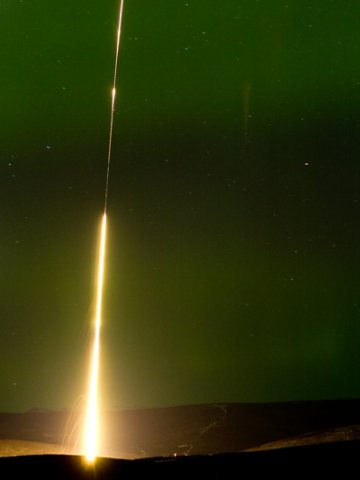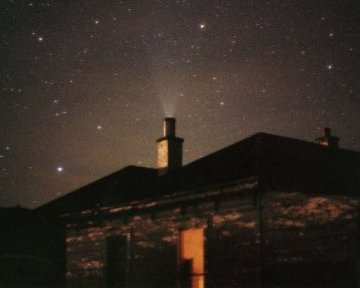 Cards, flowers, chocolate... what's missing? The heavens. Spaceweather PHONE for Valentine's Day.
Cards, flowers, chocolate... what's missing? The heavens. Spaceweather PHONE for Valentine's Day.
LUNAR ECLIPSE: Mark your calendar: On March 3, 2007, the Moon will turn an eerie shade of red for more than an hour during a total lunar eclipse. [full story] [animation]
AURORA WATCH: Sky watchers from Scandinavia to Alaska should be alert for auroras tonight. A solar wind stream is buffeting Earth's magnetic field and this could cause a geomagnetic storm. Yesterday in Skiland, Alaska, scientists at the University of Alaska's Poker Flat Research Range launched a rocket into the auroras:

Photo details: Nikon D2H, 50mm lens, 30 second exposure at f/4, ISO 400
"The launch occurred about 3:45am local time, and the picture shows the first of the four stages," says photographer Lance Parish.
Rockets like this one are launched several times each year from the Poker Flat facility. They carry instruments able to sense charged particles and electric fields into the high atmosphere where auroras are formed. Why? Because after centuries of observation and study, auroras are still not fully understood. Researchers need more data! Later this week, NASA plans to launch a fleet of five satellites to unravel the mystery of auroral substorms. Stay tuned for images and updates.
COMET MCNAUGHT: People in cities of the Southern Hemisphere have been asking, what happened to Comet McNaught? Has it faded away? "No," says photographer Ian Cooper of Glen Oroua, New Zealand. "It's just stuck in my chimney."

Photo details: Nikon F, 50mm lens, f/2, 60 seconds, Fuji Xtra 800 film.
Actually, the comet has faded. Now about as bright as a 4th magnitude star, it is no longer visible from brightly-lit cites, but it can still be seen from rural areas and it remains an easy target for off-the-shelf digital cameras. Cooper captured the comet partially hidden behind his chimney with a 60-second exposure.
Comet McNaught Photo Gallery
[finder chart] [ephemeris] [comet camera]

